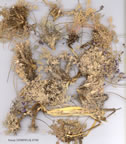| Fabaceae |
 Oxytropis persica |
| Oxytropis DC. Oxytropis persica BOISS. Ömür: Çok yıllık Yapı: ot Hayat formu: İlk çiçeklenme zamanı: 6 Son çiçeklenme zamanı: 7 Habitat: kayalık yamaçlar, çağıllıklar Minimum yükseklik: 2400 Maksimum yükseklik: 3700 Endemik: - Element: İran-Turan Türkiye dağılımı: D. ve G. Anadolu Genel dağılımı: KB. ve K. İran Bulunduğu kareler:A8 B5 B6 B7 B9 C5 C9 |
| O. persica Boiss., Diagn. ser. l(2):40 (1843). Syn: O. dioritica Boiss., Diagn. ser. 2(5): 84 (1856)! Figure 2, p. 229. Dwarf acaulous tuft-forming perennial, with a woody branched rootstock. Leaves with 6-3 pairs of leaflets, 1-3 cm long including petiole ± as long as rachis. Leaflets linear-elliptic or narrow elliptic, 3-7 xc. 1-2 mm, with a dense sericeous indumentum on both surfaces. Scapes prostrate or ascending, 4-8 cm. Inflorescence dense, capitate, 5-8-flowered, scarcely elongating in fruit. Calyx 3-4.5 mm, teeth equal to or shorter than tube, with adpressed hairs. Corolla violet or pinkish; standard 7-9 mm; wings 6-7 mm; keel 6-7 mm including a c. 1-2 mm beak. Legume inflated, ±thin-walled, ovate, shortly stipitate, 6-12 × 3-6 mm, without a septum, erect or deflexed, with an indumentum of short adpressed hairs. Fl. 6-7, fr. 8. Rocky slopes, screes, 2400-3700 m. Type: [Iran] Elburz. in cacumine montis Elamout Persiae borealis, Aucher 4420 (nolo. G!). E. & S. Anatolia. A8 Gümüşane/Erzurum: Kop Da., 2400 m, Balls 1794! B5 Kayseri: Aslan Dagh, E.S.E. of Erciyas Da., 1856, Bal. s.n.! B6 Maraş: distr. Göksun. Binboğa Da., on Işik Da., above Karli Y., 2500 m, D. 20033! B7 Tunceli: Munzur Da., above Ovacik, 2800 m, D. 31236! B9 Van: Artos Da., 3650 m, D. 22846! Van: distr. Başkale, lspiriz Da., 3200 m, D. 23764! Van/Siirt: Kavuş-şahap Da., S of Pişvanik, above Arpit, 2950 m, Watson et al. 3581! C5 Niğde: Kizil Tepe, 2450 m, Kotschy 129!, 253! C9 Hakkari: Harefta m. between Başkale and Koçanes, Sâbělek 3125. N.W. and N. Iran. Ir.-Tur. element. This alpine, often scree species is characterised by its dwarf habit, silvery leaves, small floral dimensions and, although few gatherings show it, inflated, almost bladder-like fruits. All intermediates occur between O. persica, described from N. Iran, and O. dioritica, originally described from the Taurus range, and with the material now available there are no grounds for recognising the latter taxon at any level. |